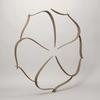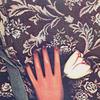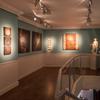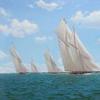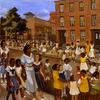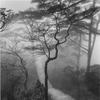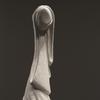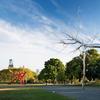Palm Beach's Norton Museum to Exhibit NASA-Embedded Artist's Works Exploring Climate Change
- WEST PALM BEACH, Florida
- /
- April 15, 2017
Norton Organizes Exhibition Exploring Climate Change, Featuring Works by Artist Justin Brice Guariglia
Unique Photographic Works by First Artist Embedded with NASA on View in Earth Works: Mapping the Anthropocene
Premieres on September 5, 2017
The Norton Museum of Art has announced a timely exhibition that depicts how humans are directly and indirectly impacting the planet. Earth Works: Mapping the Anthropocene will feature more than 30 new and recent works by Justin Brice Guariglia, a transdisciplinary artist and the first embedded in a NASA mission. Guariglia’s photographic works, which can be viewed as blurring the line between photography and painting, explore our current ecological crisis. Ranging in scale from as small as 2.5 x 3.3 feet to as large as 16 x 12 feet, these images illustrate Greenland’s melting and deteriorating glacial ice sheets and sea ice in stunning detail and on a monumental scale, as well as the impact of agriculture and mining on the Earth’s surface. The exhibition, curated by Tim B. Wride, the William and Sarah Ross Soter Curator of Photography, opens on September 5, 2017 and runs through January 7, 2018.
The Anthropocene – the age in which humans’ permanent mark on the entire planet, from the far reaches of the atmosphere to the lowest depths of the ocean – represents a new era in geologic history.
During the past two years, Guariglia has been embedded with NASA scientists flying survey missions over Greenland to study how melting glaciers affect sea level rise. NASA invited Guariglia into this unique collaboration hoping he could create works of art that spark an emotional connection to the science and inspire curiosity in the public. The images he took during these flights serve to illustrate with visual evidence, and through metaphor, the complexity of human impact on the planet.
“Justin’s works mapping man’s impact on the planet range far beyond making images that are formally and aesthetically compelling. His use of materials in the final product—the object that carries the image—is what truly sets the work apart from his contemporaries,” said Wride. “Nominally a photographer, his camera is only his first tool. Guariglia uses unique acrylic printing processes, which he is pioneering, to create his works.”
Guariglia uses an ultra-archival printing process to build layers of acrylic on substrates giving the works a physical depth and dimension. Incorporating materials such as polystyrene, gold-, palladium- and pewter-leafed panels, and aircraft grade aluminum.
Wride added: “In a poetic twist, his images become objects in which the materials, the process, and the subject reference one another to produce artifacts of incredible durability, which will endure long after his subjects are gone.”
The exhibition is divided into three sections: Agriculture and Mining, Glacial Ice, and Sea Ice. In Agriculture and Mining, shimmering panels measuring up to 80 x 60 inches are layered with gold and other precious-metal leaf, gesso, and acrylic ink, to depict the impacts of agriculture and mining on the Asian continent, where Guariglia spent 20 years living and working for Smithsonian, The New York Times, and numerous other publications as a photographer. In this section, in a series titled Landscape Studies (2015-2016), Guariglia depicts visual evidence of global warming. In a reverse echo of the stripping process of mining, Guariglia’s printing process creates images by adding many layers of ink, whereas these damaged landscapes were created by removing one layer of earth at a time.
As an embedded artist with the NASA’s Operation IceBridge, Guariglia has flown over Greenland on numerous missions during the past two years to capture images of the 110,000-year-old glaciers covering the island-nation’s surface. In the Glacial Ice section of the exhibition, JAKOBSHAVN I (2015-2016)—a nine-panel work that is 16 x 12 feet—shows the now-disappeared surface of a “galloping glacier” that deposits 38 billion tons of ice a year into the ocean, a pace which is increasing yearly due to rising temperatures from human impacted climate change. QAANAAQ I (2015-2016), recently acquired by the Norton for its collection, is a 10.5 x 8 foot, four-panel work that depicts the ever changing icy landscape of a Greenland in flux. Guariglia, however, has chosen to print this abstract scene on polystyrene—a material that will last for thousands of years, and is one of the markers of the Anthropocene that is destined to become part of the fossil record, which will delineate the epoch.
The final section, Sea Ice offers dark black images with a scattering of white constellations recall the heavens, but in fact depict sea ice, the cast offs and remnants of dying glaciers, as seen from the troposphere and stratosphere. Resembling tiny far-flung archipelagoes, these images depict the new realities of dwindling sea ice coverage in our arctic oceans.
After debuting at the Norton, the exhibition will travel to the USC Fisher Museum of Art at the University of Southern California in Los Angeles.
Justin Brice Guariglia was born in 1974 and lives and works in Brooklyn, New York. He is a trans-disciplinary artist working at the nexus of painting, printmaking, photography, and sculpture. His work explores ecology through the lens of politics, culture, science, journalism, mythology and art history. His experimentation with materials, processes, and techniques inform and shape the work, forging new ways of seeing and experiencing the world. Guariglia’s work is in the collections of the Norton Museum of Art; the Museum of Fine Arts, Houston; and numerous private collections.
For additional information, please call (561) 832-5196, or visit www.norton.org.


